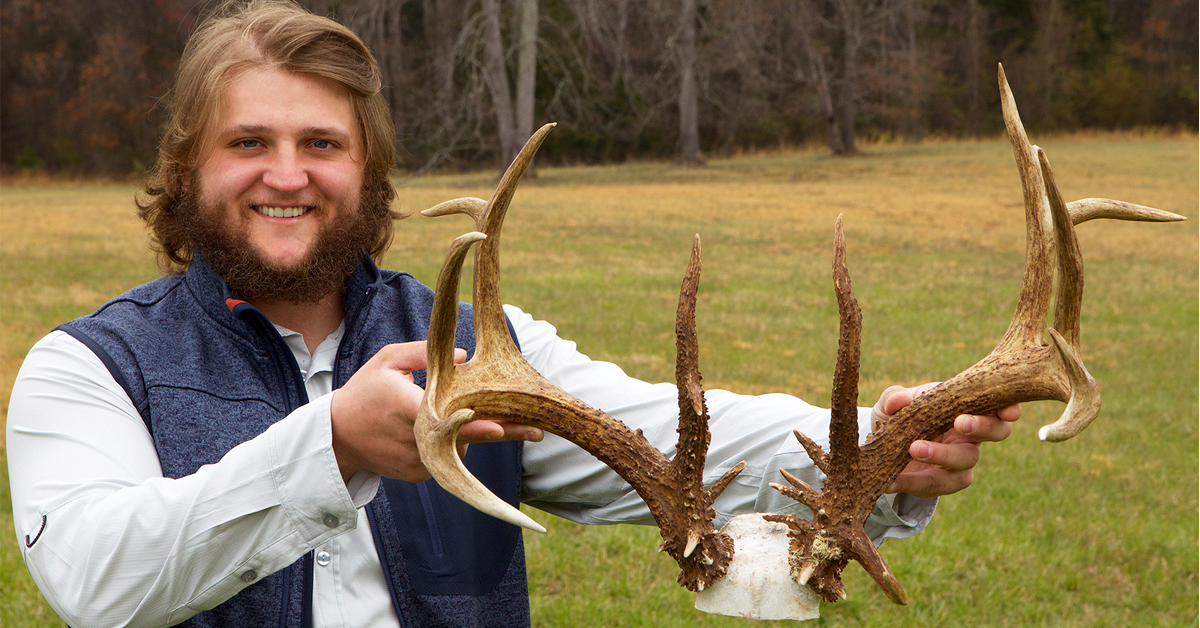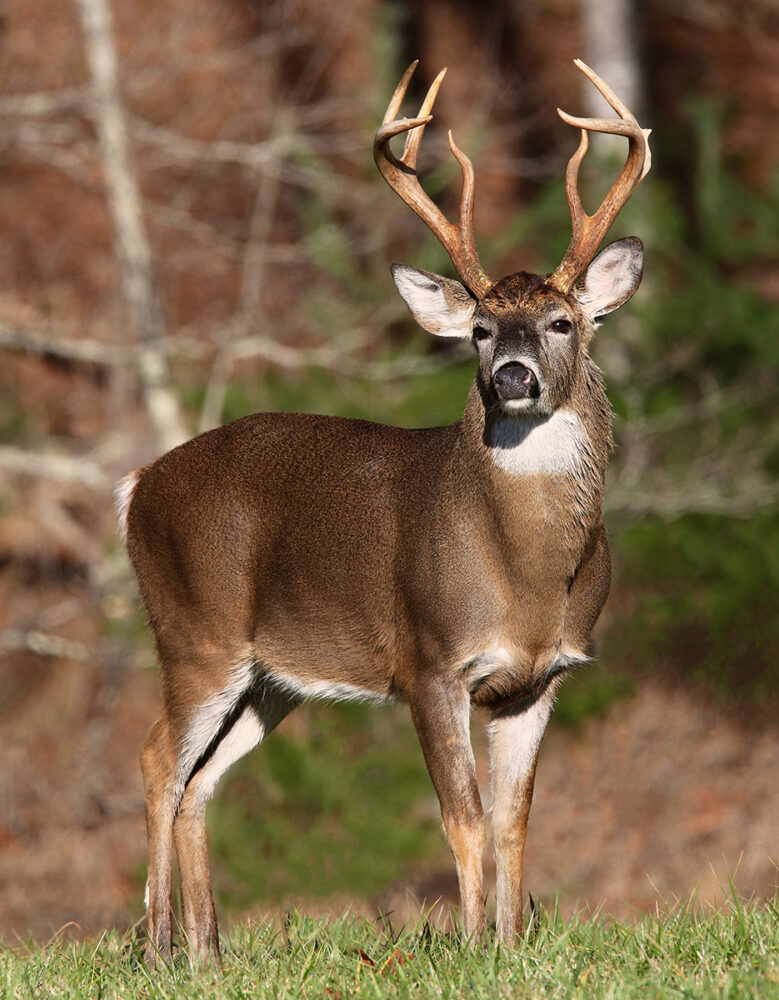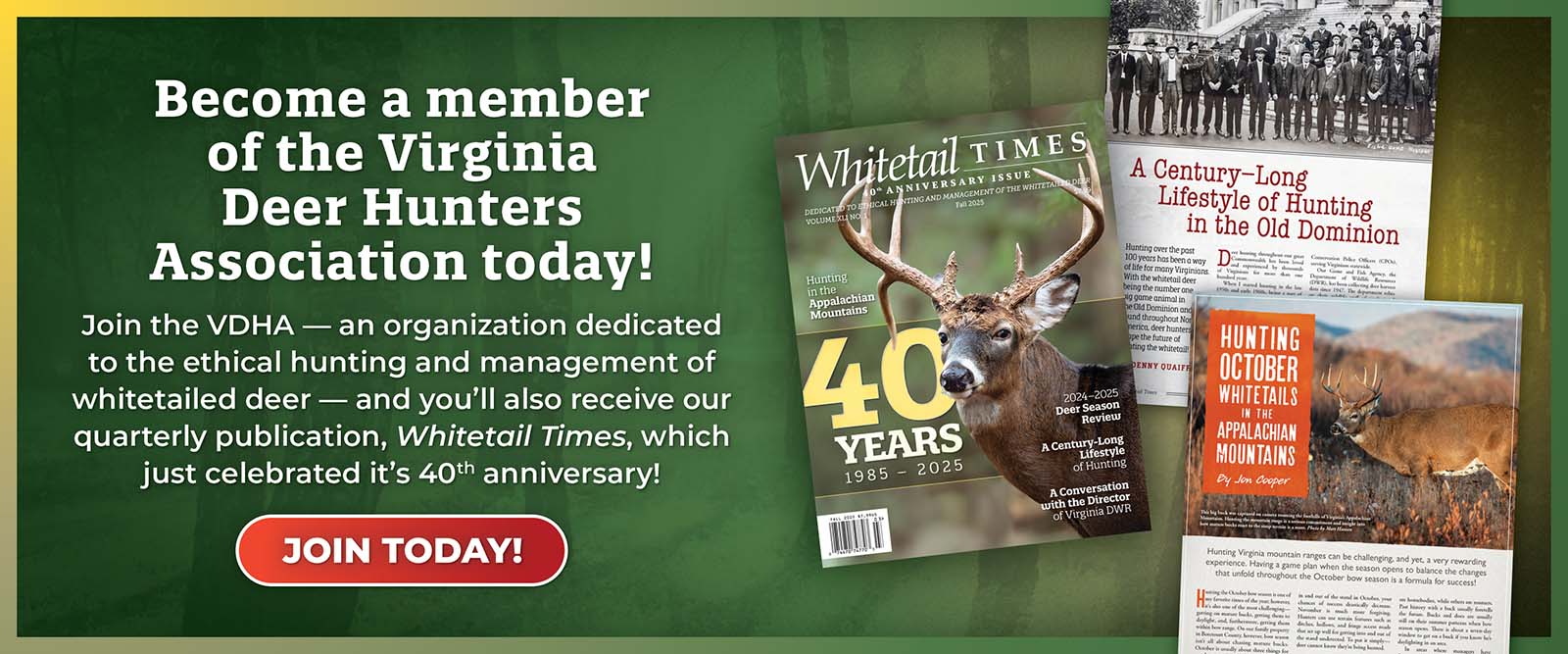
All smiles, Peter Sutphin and the antlers of his 2017 Halifax County, non-typical buck that netted 190 7/8 inches - truly a magnificent buck by anyone’s standards!
By Mike Roberts for Whitetail Times
The whitetail deer is, by far, the most popular game species in North America. Hunting methods and advanced gear have revolutionized the sport but harvesting wall-hangers on a regular basis still requires behavioral knowledge, persistence, and waltzing with an unlikely partner.
As an avid, next-generation whitetail deer hunter, Peter Sutphin had done everything by the book for several years. Sowing both warm-season grasses and winter food sources, utilizing trail cameras, glassing summertime hayfields, and scouting for shed antlers during late winter, Peter’s goal was harvesting, or helping a brother or a friend harvest, one of two mature bucks ranging across his 60-acre parcel in Halifax County. The buck of his dreams, dubbed Willie, sported a heavy 10-point set of antlers with several stickers. Like many mature whitetails, ol’ Willie was showing up on camera during nighttime hours and with no well-defined pattern of movement.
Finally, in November of 2014, Sutphin laid eyes on the buck for the first time. Although Willie walked within shooting range, he was just across the boundary of a neighbor’s property. Passing up that shot speaks volumes about Sutphin’s ethical conduct and the future of the sport! Two years later, 2016, the buck vanished off the radar screen. Though fearing the worst, in February Sutphin discovered a recent shed, with a number of new, non-typical points protruding from the base. That ghostly creature had survived a severe hemorrhagic disease outbreak and two more hunting seasons. The game was still on!
Come 2017, and realizing the buck was in his prime, Sutphin continued the pursuit with renewed optimism. While Sutphin was filming a friend’s archery hunt one evening, Willie showed up, but stayed just outside of the fellow’s comfort zone. There was no way either of them would gamble on anything less than a perfect, broadside shot. To say the least, it was heart-wrenching to watch Willie walk away!
On Wednesday morning of the second week of blackpowder season, a work commitment forced Sutphin to stay home. Peering out an upstairs bedroom window, he saw a buck sporting massive antlers disappearing into the woods behind the house. Instinctively grabbing the muzzleloader and rushing downstairs and out the door, down the porch steps, and into the yard, the surprised hunter could not believe his eyes when Willie strolled back out into the field with his nose on the ground. A steady rest and squeeze of the Knight’s trigger dropped the buck in his tracks, thus ending the four-year quest.
After the mandatory 60-day drying period, the 7 1/2-year-old buck’s antlers netted a whopping 190 7/8 inches. The most unbelievable part of the story, other than Lady Luck’s role, was that the rack had added more than 25 inches from the previous year.
I dare say if we interviewed every hunter who has harvested a Boone and Crockett whitetail, there was a rabbit foot involved with the majority of them. And for all those blown opportunities, there was likely some circumstantial bad luck involved, too. It’s just the nature of the beast!
Regarding trophy whitetail deer in Virginia, there is no “sure fire” means of hanging heavy antlers on the wall. The good news, the Commonwealth’s deer herd is, for the most part, healthy. Sportsmen are blessed with lengthy, multiple seasons to utilize a wide range of equipment, including traditional archery, compound bows, crossbows, blackpowder rifles, rifled-barreled shotguns, centerfire rifles and the Johnny-come-lately tactical.
Some seasoned hunters declare the opportune time for bagging bruiser bucks is during the pre-rut, others say late in the season when limited food sources become the animals’ primary focus. One fraternity cherishes pushing the wary animals out of heavy cover with hounds. From October through the first weekend of January, hunters can, in one way or another, stalk whitetails from the Allegheny Mountains to the Tidewater marshes. Toss in all the technology currently available and the sport transitions in a manner never imagined by old-school “stump sitters.” These tools and gadgets, along with the application of basic behavioral knowledge, tend to maximize the advantage over a mature buck’s acute senses.
Deer hunting, in general, is about opportunity, which equates to being in the woods whenever possible. There are folks who would have us believe we are wasting our time sitting in a stand outside of those prime periods of activity defined by the red moon chart. For sure, there are times when wildlife becomes more active—every birdwatcher and fisherman knows that to be true. But to stay in bed because of some theoretical moon phase chart hinges on lunacy (pardon the pun), and in reality, reduces the odds of encountering a trophy buck.

Although this buck’s antlers are not Boone and Crockett caliber, his head structure, chest diameter, sway back and sagging belly indicate a mature animal, making him a very respectable trophy!
What’s the best approach for tagging a real monster? First, unless there is a mature buck in the vicinity, you are wasting your time. However, there is usually one, old, crafty stag in every locality! And if not, come mid-November, chances are one will show up in search of does. The single fact hunters must realize is that only a percentage of 5 1/2-year-old, free-ranging bucks grow Boone and Crockett caliber antlers, no matter the amount of protein ingested. Genetic mapping passed through successive generations is one of the three necessary, and perhaps most important, components of trophy antlers. Of those basics, age is another element of extreme importance. Most bucks, however, are harvested prior to reaching an age that produces maximum antler potential. Thankfully, that trend seems somewhat in reversal.
In consideration of pursuing big bucks, any mature whitetail is a true trophy, regardless of antler size. The score of the deer’s headgear has no bearing on his level of wit. Once a buck reaches a certain age and learns all the extra human activity in the forest during autumn is a genuine threat, he becomes a reclusive creature. The only chinks in his armor are when November testosterone levels peak and whenever winter’s bitter temperatures pull him out of heavy, thermal cover to fill an empty belly. Even then, some of the mature bucks become nocturnal ghosts that eventually perish of old age right under our noses!
There are other factors that affect the odds of taking a mature buck in Virginia. As already declared, the Old Dominion’s deer herd is in great shape; a direct result of the Virginia Department of Wildlife Resources’ long-term deer management plan. This effort, based on sound science, has some glitches, because of circumstances beyond the agency’s control. Areas in our beloved national forests contain extensive stands of mature hardwoods, which choke out light and minimize the understory. Such is a concern for local deer herds. Not only is food quality the third primary factor controlling antler size, availability is vital to overall populations. Even with reduced bag limits, without habitat containing plant succession, deer numbers decline. The only fix is revised forestry practices, meaning increased timber harvest on public lands.
Then there is the predation concern. When it comes to whitetail predators, such as coyotes, bears, bobcats, and dogs, there is far more myth expressed than facts. Deer have adapted to every obstacle Mother Nature has thrown at them throughout the ages and will continue to do so successfully. As a naturalist, my opinion (based on personal observation) is that the majority of losses occur during the first few hours and days following birth; that is when they are most vulnerable. Even though fawns utilize several, remarkable, behavioral adaptations to survive the eyes and noses of predators, many succumb.
Case in point, 20 years ago Shenandoah National Park’s Big Meadows was the number one place in Virginia to photograph fawns during early June. Nowadays, it is difficult to find even one hidden in the huckleberry vines. Two years ago, I spent an entire day exploring the 100-acre meadow and discovered pieces of chestnut-colored skin and tiny hooves scattered about in five separate locations. As one of the smartest mammals on the planet, coyotes have learned when and where doe whitetails give birth. Even so, the jury is still out on this apex predator’s overall effect on annual fawn recruitment.
And make no mistake about it, several Eastern coyotes hunting together can take down a mature whitetail. Such may not happen frequently, but it does on occasion. Some years back it was my fortune to locate, follow, and photograph a truly outstanding whitetail buck in the Cade’s Cove area of the Great Smokey Mountain National Park. Long, forked brow tines magnified that handsome fellow’s symmetrical, 12-point rack. After two days of photography, he disappeared. Finally, on the fourth morning, I found him standing in a stream. Upon approach, it quickly became apparent something was terribly wrong. Circling for a better look, I could see he was hamstrung and bleeding profusely—telltale evidence of a candid attack. This was my last encounter with one of the biggest bucks of my life. What seemed cruel behavior was merely the mechanics of nature at work!
As for other mammalian predators, black bears also take their share of newborn fawns. Bruins have poor eyesight, but the sharpest sense of smell of any animal in the forest. As bear numbers increase, and they surely are across Virginia, an increased percentage of fawn whitetails will fall victim.
Seldom do we consider the bobcat tackling deer-sized prey. Yet, a week-old fawn is no match for a 35-pound tom. Domestic dogs, both pets that run free and the feral type, opportunistically kill.
A point seldom discussed about predators is that their mere presence affects hunting. If there is a population of black bears or concentration of coyotes in the area, deer act differently. They seem to always be on guard—and for darn good reason!
While on the subject of deer survival, perhaps we should acknowledge another sort of threat to individual animals and, in some cases, the general population. Whitetail deer, like all wildlife, are at the mercy of a lengthy list of pathogens, both bacterial and viral. Hemorrhagic disease (HD) continues to raise its ugly head in different parts of Virginia each year, with increased outbreaks in the western portion of the state. HD is a virus spread by biting midges, which emerge from muddy margins during dry weather conditions in late summer and early autumn. Cold temperatures and frost are the vectors’ only deterrent. Most of the victimized and dying deer head to water in an attempt to cool their fever-ravaged bodies. The changing natural environment, higher mean temperatures, and extended periods of drought could have an impact on future whitetail populations.
To the dismay of DWR officials, the number of chronic wasting disease (CWD) cases has increased significantly. Unlike hemorrhagic disease, CWD is transmitted animal-to-animal and is always fatal. This horrific disorder affects the cervid’s brain through the transfer of proteins called prions, which are neither bacterial or viral. Curtailing the common practice of feeding deer is one of the agency’s current preventive suggestions.
When it comes to deer losses, another deadly situation that exists is deer/automobile collisions. Each year, and more frequently during autumn, an estimated 6,500 collisions with whitetails are reported on highways across the Commonwealth.
What does all the aforementioned material have to do with hunting trophy whitetail deer? It is merely a reminder that whitetails face life-and-death situations, in one form or another, from the moment of birth. For a buck to reach maturity means beating the overwhelming odds of hungry predators, deadly pathogens, parasite infestations, speeding automobiles, legal hunters with a lust for fresh venison and, the unfortunate scourge of the sport, poachers! Therefore, every whitetail buck lucky enough to reach maturity deserves our respect, even as we are calling it in on the phone check.
Yes, for the record, I’m one of those old-school “stump sitters.” To me, with certain restraints, technology can be a wonderful hunting aid. Yet I believe that to set up multiple trail cameras near piles of corn to stream real-time images to a computer while on the job is nothing short of unethical activity. It is akin to flying drones during hunting season. Much of this stems from marketing schemes viewed on televised hunting shows where sponsors depend on selling product. Too, the host’s success is based on making kills during each episode.
For me, I prefer the simple thrill of being in the Great Outdoors to scout an area, read sign, sit in my tree stand during the middle of the day and, with rifle ready, embrace Lady Luck when she extends her hand for the dance!
Mike Roberts, who lives in Evington, Virginia, is the long-time director of ‘Return to Nature,’ which educates students about our natural resources. Mike is also an avid hunter and big game guide. Readers can contact Mike with questions and comments at return2nature@aol.com.
©Virginia Deer Hunters Association. For attribution information and reprint rights, contact Denny Quaiff, Executive Director, VDHA.


